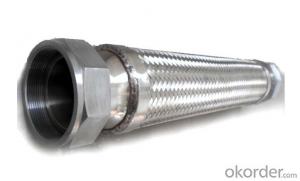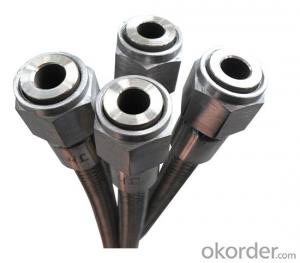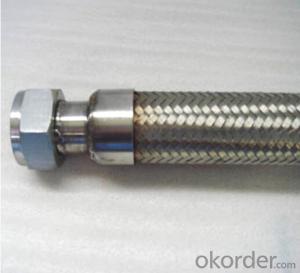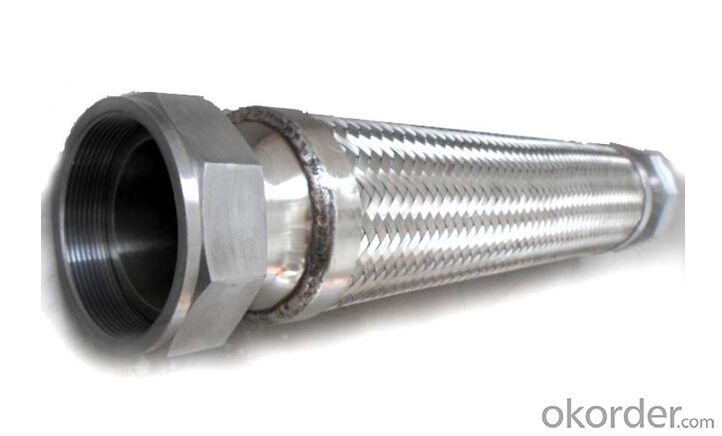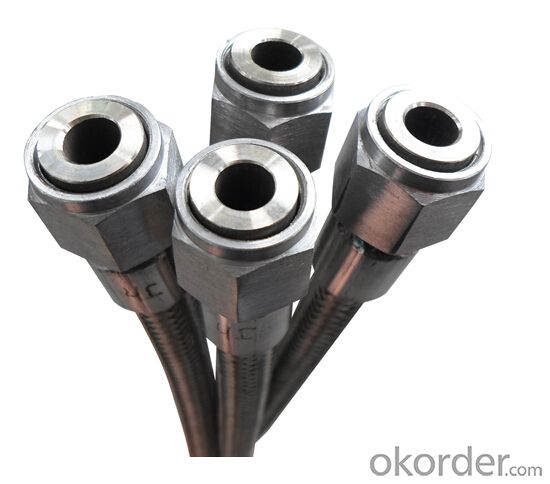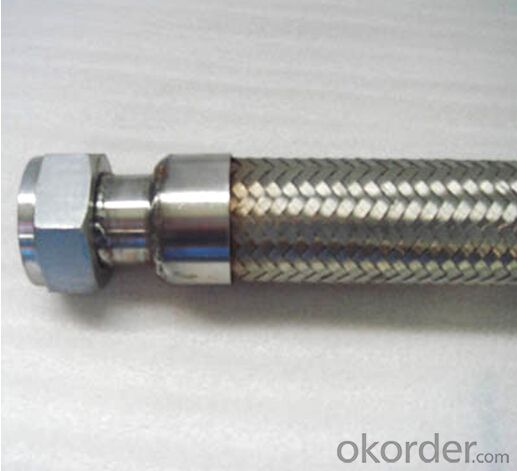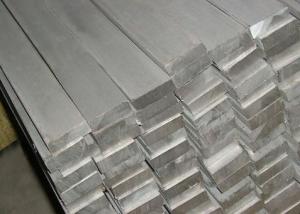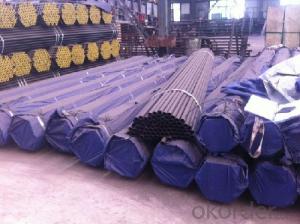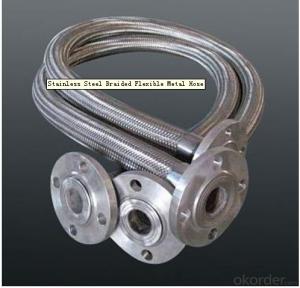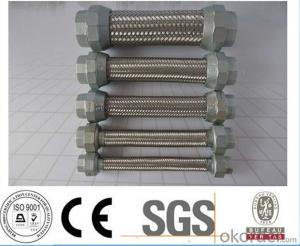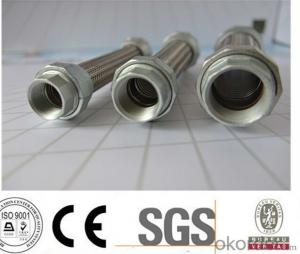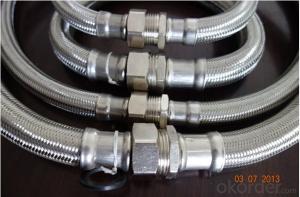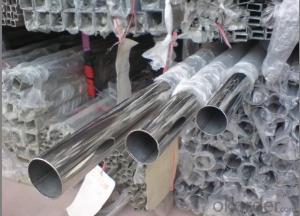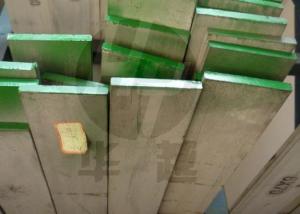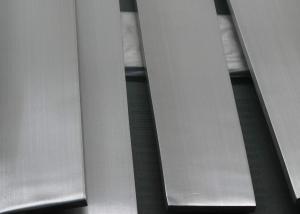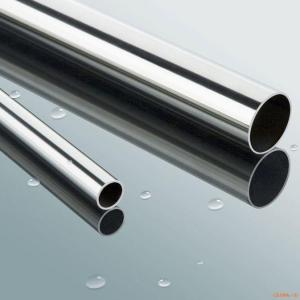Stainless Steel Braid Hose with Flexible Material
- Loading Port:
- Tianjin
- Payment Terms:
- TT OR LC
- Min Order Qty:
- 1000 pc
- Supply Capability:
- 100000 pc/month
OKorder Service Pledge
OKorder Financial Service
You Might Also Like
Specification
Stainless Steel Braid Hose with Flexible Material
Applications of Stainless Steel Braid Hose with Flexible Material:
--Refueling system
--Chemical and pharmaceutical industry
--Industrial hydraulic systems
--Air conditioners in industrial and construction –site vehicles
--Food and beverage industry
--Special and standard industrial applications
--Water and cleaning management
Features of Stainless Steel Braid Hose with Flexible Material:
1. )O. D.: 13-18MM 0.2-3M long
2. )Nut.: Nickel/Chrome Plated Brass (Zinc / Iron / Aluminum is available)
3. )Size Of Nut.: Female&Male 1/2''; 3/4''; 3/8''; 7/8''; 5/16'', and M10...
4. )Insert.: Brass (Zinc / Aluminum / Plastic is available)
5. )Inner tube.: Rubber/ EPDM/PVC
6. )Covered Material: Stainless Steel 201, 301, 304 /Aluminium Wire
7. )Working Pressure: 5Kg-15Kg
8. )Temperature: 0-92° C
9. )Quality Assurance: 3 years
RemarkAPPLICATION: HOUSEEHOLD WARE, BATHROOM WARE, SHOWER HOSE
PAYMENT: T/T, L/C
DELIVERY TIME: 20DAYS OR 30DAYS AFTER RECEIVED 30% DEPOSITS
MOQ: 5000PCS
ODM&OEM IS ACCEPTABLE
PackageInner: PP bag /Blister packing Outer: Carton box
Specifications of Stainless Steel Braid Hose with Flexible Material:
NO | I.D | Refer to O.D | Working pressure | Burst pressure | approximate Weight | |||||
(inch) | (mm) | (inch) | (mm) | MPa | Psi | MPa | Psi | kg/m | lbs/ft | |
1 | 1/8 | 3.2±0.2 | 0.35 | 9±0.3 | 2.06 | 300 | 8.27 | 1200 | 0.078 | 0.12 |
2 | 5/32 | 4±0.2 | 0.4 | 10±0.3 | 2.06 | 300 | 8.27 | 1200 | 0.092 | 0.14 |
3 | 3/16 | 4.8±0.2 | 0.43 | 11±0.3 | 2.06 | 300 | 8.27 | 1200 | 0.108 | 0.16 |
4 | 1/4 | 6.3±0.3 | 0.5 | 12.7±0.3 | 2.06 | 300 | 8.27 | 1200 | 0.134 | 0.2 |
5 | 5/16 | 8.0±0.3 | 0.56 | 14±0.3 | 2.06 | 300 | 8.27 | 1200 | 0.147 | 0.22 |
6 | 3/8 | 9.5±0.3 | 0.63 | 16±0.4 | 2.06 | 300 | 8.27 | 1200 | 0.182 | 0.27 |
7 | 15/32 | 12±0.3 | 0.75 | 19±0.5 | 2.06 | 300 | 8.27 | 1200 | 0.238 | 0.35 |
8 | 1/2 | 12.7±0.4 | 0.78 | 20±0.5 | 2.06 | 300 | 8.27 | 1200 | 0.262 | 0.39 |
9 | 5/8 | 16±0.4 | 0.94 | 24±0.5 | 1.03 | 150 | 4.12 | 600 | 0.351 | 0.52 |
10 | 3/4 | 19±0.4 | 1.13 | 28.8±0.5 | 1.03 | 150 | 4.12 | 600 | 0.515 | 0.77 |
11 | 1 | 25.4±0.5 | 1.38 | 35±0.6 | 1.03 | 150 | 4.12 | 600 | 0.637 | 0.95 |
Images of Stainless Steel Braid Hose with Flexible Material:
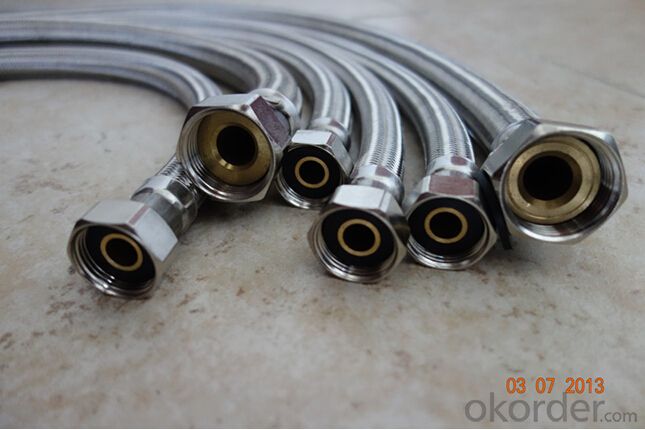
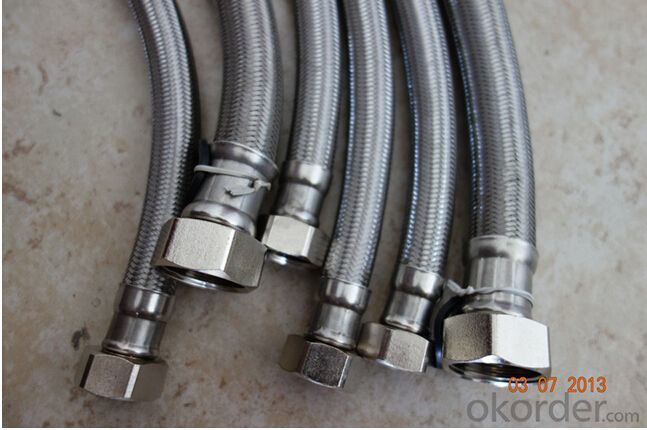
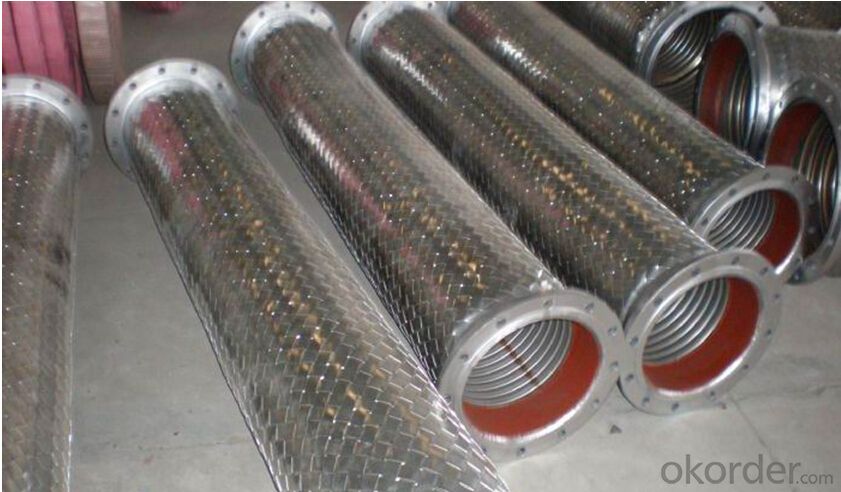
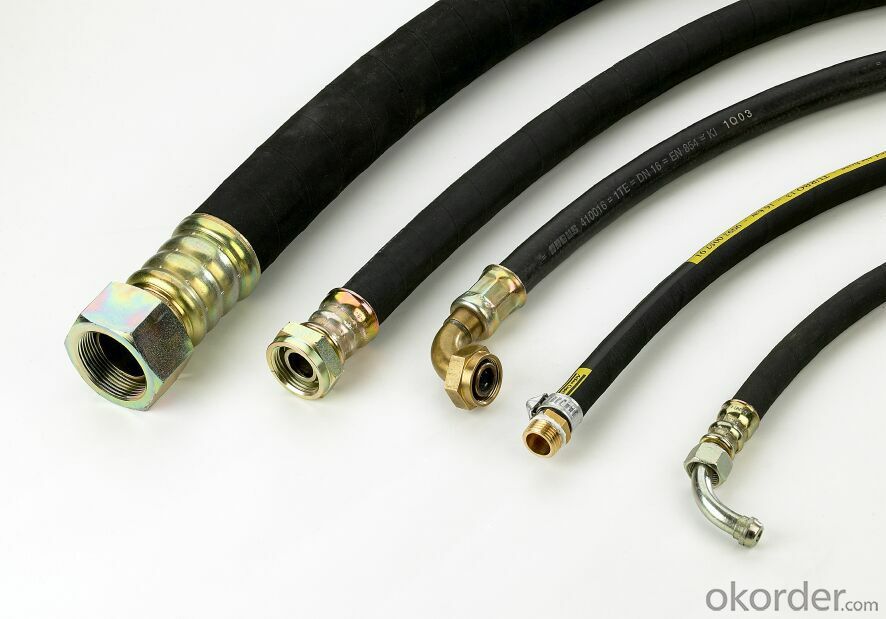
Package of Stainless Steel Braid Hose with Flexible Material:
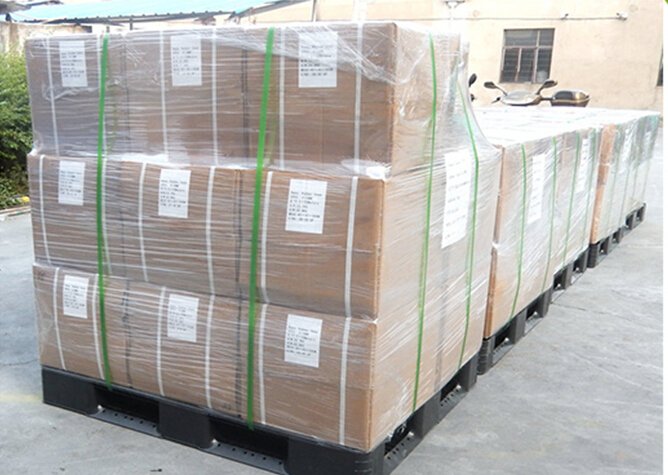
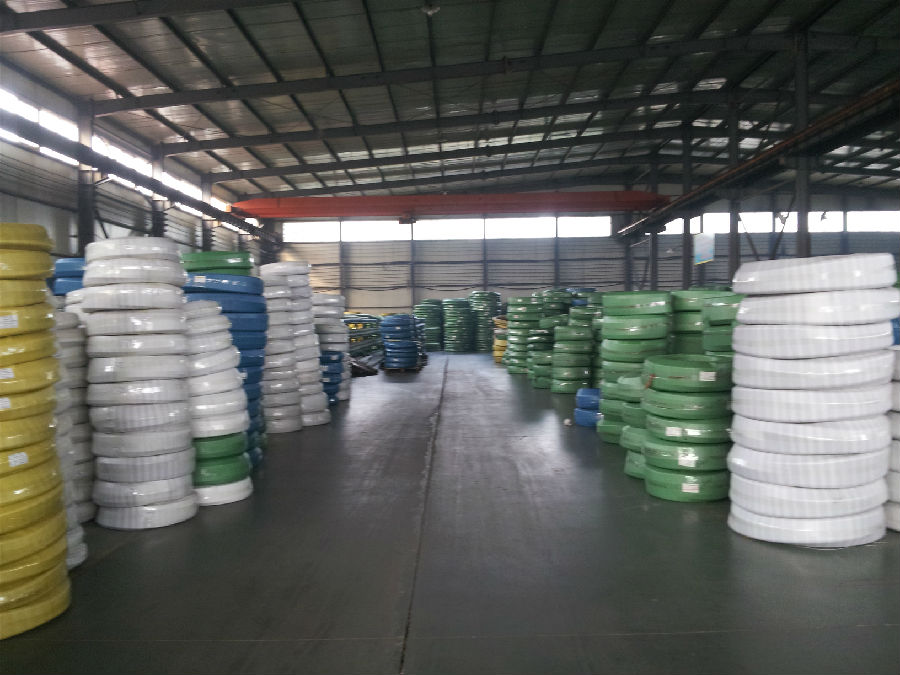
FAQ of Stainless Steel Braid Hose with Flexible Material:
Who we are:
Answer: We CNBM is a Chinese state-owned enterprise ranked 267th among the Global Fortune 500, as the largest building materials company,we have over 300 affiliated companies,and so many production lines and branch office distribute in China.
2. About our quality:
Answer: Every product needs to be quality proved before shipping.
3. About our service:
Answer: We could gurantte that we can reply you in 2 working hours.
- Q: What are the weight limitations for stainless steel pipes?
- The weight limitations for stainless steel pipes can vary depending on various factors such as the diameter, wall thickness, and overall length of the pipe. It is best to consult the manufacturer or refer to industry standards and specifications to determine the specific weight limitations for a particular stainless steel pipe.
- Q: How do stainless steel pipes compare to fiberglass-reinforced pipes?
- Both stainless steel pipes and fiberglass-reinforced pipes are popular options for a range of uses. However, they possess distinct qualities that differentiate them from each other. To begin with, stainless steel pipes are renowned for their exceptional durability and strength. They can endure high pressure, temperature, and corrosion, making them suitable for industrial and heavy-duty applications such as oil and gas, chemical processing, and plumbing systems. Additionally, stainless steel pipes are non-combustible and have a lengthy lifespan, reducing the need for frequent replacements. In contrast, fiberglass-reinforced pipes (FRP) offer unique advantages in specific circumstances. FRP pipes are lightweight and possess excellent chemical resistance, making them ideal for use in corrosive environments like wastewater treatment plants, desalination facilities, and chemical processing plants. Moreover, FRP pipes outperform stainless steel pipes in terms of insulation properties, which can be advantageous in situations requiring thermal insulation. In terms of cost, stainless steel pipes generally carry a higher price tag compared to fiberglass-reinforced pipes. However, it is crucial to consider the project's specific requirements and the expected lifespan of the pipes when assessing overall cost-effectiveness. Ultimately, the choice between stainless steel pipes and fiberglass-reinforced pipes hinges on the particular needs of the application. If durability, strength, and resistance to high pressure and temperature are the primary considerations, stainless steel pipes are the preferred option. Conversely, if factors such as weight, corrosion resistance, and insulation properties take precedence, fiberglass-reinforced pipes may prove to be the superior choice.
- Q: Can stainless steel pipes be used for vacuum systems?
- Yes, stainless steel pipes can be used for vacuum systems. Stainless steel is highly resistant to corrosion and has high strength, making it suitable for maintaining a vacuum environment without compromising its integrity.
- Q: Stainless steel pipe chamfering how to process?
- The use of fast machine chamfering is the trend of mechanical industry. The utility model overcomes the defects of the processing of the existing machinery and the electric tool, and has the advantages of convenience, quick and accuracy, and is the best choice for chamfering the metal object at present. According to the chamfer, it needs to be divided into straight line, chamfer and curve chamfer.
- Q: Are stainless steel pipes suitable for pulp and paper mills?
- Yes, stainless steel pipes are suitable for pulp and paper mills. They offer excellent corrosion resistance, durability, and high temperature resistance, making them ideal for handling various chemicals and fluids used in the pulp and paper industry. Additionally, stainless steel pipes are easy to clean, reducing the risk of contamination and maintaining high hygienic standards required in these mills.
- Q: Can stainless steel pipes be used for pharmaceutical industries?
- Indeed, stainless steel pipes find utility within the pharmaceutical industries. Owing to its exceptional resistance to corrosion, durability, and hygienic qualities, stainless steel is widely employed in this sector. Its ability to withstand chemicals, high temperatures, and moisture renders it suitable for diverse applications throughout the pharmaceutical manufacturing processes. Stainless steel pipes frequently serve the purposes of conveying and preserving pharmaceutical products, as well as facilitating the distribution of purified water, steam, and other fluids. Moreover, stainless steel is easily cleaned and maintained, a vital aspect in guaranteeing the cleanliness and sterility mandated in pharmaceutical facilities.
- Q: How do stainless steel pipes compare to brass pipes?
- Stainless steel pipes are generally more durable, corrosion-resistant, and have higher heat resistance compared to brass pipes. Additionally, stainless steel pipes are often more cost-effective in the long run due to their longevity and low maintenance requirements. Brass pipes, on the other hand, are known for their excellent conductivity and aesthetic appeal. Ultimately, the choice between stainless steel and brass pipes depends on the specific needs and preferences of the application.
- Q: Can stainless steel pipes be used for architectural sculptures?
- Certainly, architectural sculptures can utilize stainless steel pipes. Stainless steel, being a versatile material, provides durability, corrosion resistance, and an elegant appearance. These attributes make it a favored option for sculpting and constructing architectural elements. By manipulating stainless steel pipes, artists and architects can manifest their imaginative concepts in diverse forms and dimensions. Furthermore, the ability of stainless steel to endure extreme weather conditions and its minimal upkeep needs render it appropriate for outdoor installations. In conclusion, when it comes to architectural sculptures, stainless steel pipes present a dependable and aesthetically pleasing choice.
- Q: 304 stainless steel seamless tube weight how to calculate?
- The common marking methods in the market are 00Cr19Ni10, SUS304, in which 00Cr19Ni10 is generally used to indicate standard production of the national standard. Generally speaking, ASTM standard production is indicated, and SUS 304 represents standard production.
- Q: How do stainless steel pipes differ from other types of pipes?
- Stainless steel pipes differ from other types of pipes in several ways. Firstly, stainless steel pipes are known for their exceptional corrosion resistance. The presence of chromium in stainless steel forms a protective layer on the surface, preventing rust and corrosion even in harsh environments. This makes stainless steel pipes highly durable and long-lasting compared to other types of pipes. Secondly, stainless steel pipes have high strength and are able to withstand significant pressure and temperature variations. This is particularly important in industries where pipes are subjected to high levels of stress or extreme conditions. Stainless steel pipes can handle these conditions without compromising their structural integrity. Additionally, stainless steel pipes are highly versatile and can be used in a wide range of applications. They are commonly used in industries such as oil and gas, chemical processing, food and beverage, pharmaceuticals, and construction. Stainless steel pipes can handle different types of fluids, including corrosive substances, acids, and gases, making them suitable for various industries and applications. Furthermore, stainless steel pipes have excellent hygienic properties. They are easy to clean and maintain, making them ideal for applications where cleanliness is crucial, such as in the food and beverage industry or in medical facilities. The smooth surface of stainless steel pipes also prevents the accumulation of bacteria and other contaminants. Lastly, stainless steel pipes are aesthetically pleasing and offer a modern and sleek appearance. This makes them suitable for architectural and decorative purposes, such as in building structures, handrails, or furniture. In summary, stainless steel pipes differ from other types of pipes due to their corrosion resistance, high strength, versatility, hygienic properties, and aesthetic appeal. These characteristics make stainless steel pipes a popular choice in various industries and applications.
Send your message to us
Stainless Steel Braid Hose with Flexible Material
- Loading Port:
- Tianjin
- Payment Terms:
- TT OR LC
- Min Order Qty:
- 1000 pc
- Supply Capability:
- 100000 pc/month
OKorder Service Pledge
OKorder Financial Service
Similar products
Hot products
Hot Searches
Related keywords
